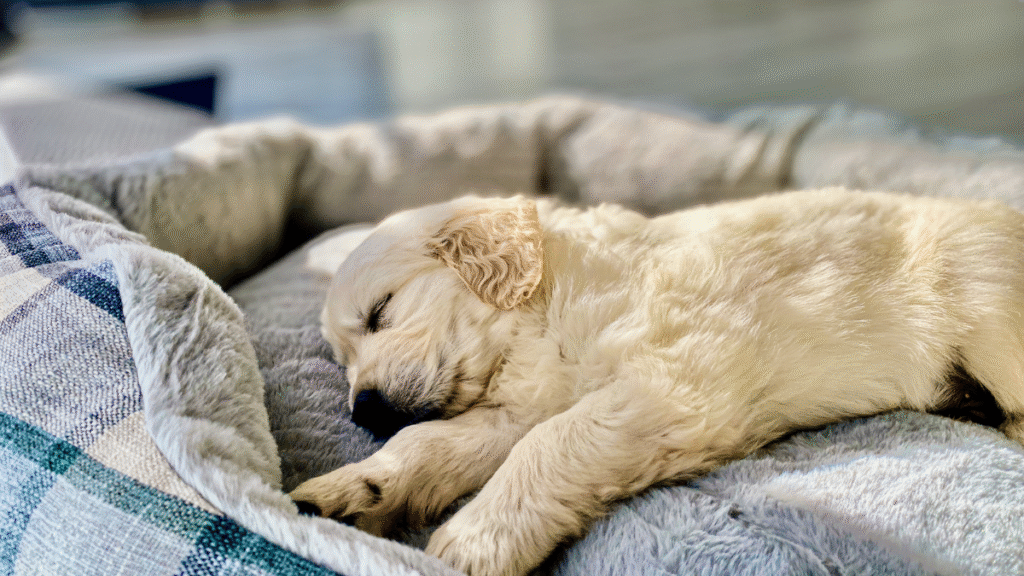If you’ve just brought a new puppy home, you’re probably over the moon with excitement and joy—but you may also be struggling to get a full night’s sleep.
Between late-night whining, restless pacing, and multiple potty breaks, puppies can be a real challenge. Training your puppy to sleep through the night takes time, patience, and consistency.

Why Puppies Don’t Sleep at Night
Before you start training your puppy to sleep through the night, it helps to understand why this can be so challenging.
1. They’re adapting to a new life
Your puppy has just left their mother and littermates, so they need time to adjust to their new surroundings. Unfamiliar smells, sounds, and sights can make them feel anxious or lonely at night.
2. They have small bladders
The most common reason puppies can’t sleep through the night is that they physically can’t hold their bladder for very long. Most young puppies can only sleep a few hours without needing a potty break—especially those under 12 weeks old.
3. They have lots of energy
Puppies spend their days exploring, running, playing, and learning about their world. If they haven’t had enough exercise or mental stimulation, they may be too wound up to settle down at bedtime.
4. They lack a routine
Puppies thrive on structure. Without a consistent bedtime routine, your puppy won’t recognize that it’s time to wind down and sleep.
Keeping these reasons in mind will help you train with patience and understanding. Your puppy isn’t trying to test you—they simply need to learn what’s expected.
10 Steps for Teaching Your Puppy to Sleep Through the Night
With those basics covered, here are ten effective steps to help your puppy rest peacefully through the night.
1. Create a Comfortable Sleeping Space
Provide your puppy with a quiet, cozy area to sleep in your home.
Choose the right spot:
Pick a corner that’s quiet, draft-free, and away from bright lights or heavy foot traffic.
Use a crate or playpen:
Crate training is one of the best tools for teaching your puppy to sleep through the night. A crate mimics a den, offering a sense of security and helping to prevent accidents.
Make sure the crate is:
-
Spacious enough for your puppy to stand, turn around, and lie down comfortably
-
Lined with a soft bed or blanket
-
Furnished with a safe chew toy or stuffed animal for comfort
If possible, place the crate near your bed for the first few weeks. The sound of your breathing can help calm your puppy and reassure them that they’re not alone.

2. Establish a Consistent Bedtime Routine
Puppies do best when they know what to expect. A predictable routine signals that it’s time to rest.
A simple evening schedule might include:
-
Playtime before bed: Give your puppy a final burst of energy with a short play session.
-
Quiet time: Switch to calm activities—gentle petting, light cuddling, or quiet play—about 30 minutes before bed.
-
Final potty break: Take your puppy outside right before bed to avoid accidents.
-
Bedtime cue: Use a consistent phrase like “bedtime” or “go to sleep.” Over time, your puppy will associate these words with nighttime rest.
Try to stick to the same sleep and wake times every day, even on weekends. Consistency is crucial.
3. Manage Food and Water Intake
Your puppy’s eating and drinking schedule affects their ability to sleep through the night.
-
Feed dinner a few hours before bedtime to allow for digestion.
-
Limit water about one to two hours before bed, but never withhold it during the day.
-
Always take your puppy outside right after eating or drinking.
Managing food and water in the evening helps minimize middle-of-the-night potty breaks and whining.

4. Tire Them Out During the Day
A tired puppy is a sleepy puppy. Make sure your puppy gets plenty of physical and mental stimulation throughout the day.
Ideas to tire out your puppy:
-
Age-appropriate walks based on their breed and size
-
Playtime with toys such as balls, ropes, or chew toys
-
Short training sessions that reinforce commands with positive rewards
-
Puzzle feeders or snuffle mats for mental enrichment
Avoid vigorous play right before bed, as it can overstimulate your puppy and make it harder for them to settle down.
5. Address Nighttime Whining the Right Way
New puppies often whine or cry at night, especially during the first few weeks. This is normal—it’s part of the adjustment process.
How to respond:
-
Stay calm and consistent. Don’t immediately rush to them when they cry, or they’ll learn that whining gets attention.
-
Check for real needs. If it’s been a few hours since their last potty break, calmly take them outside, then return them to bed without extra play.
-
Never punish them. Yelling or scolding only increases anxiety and makes nighttime training harder.
Most puppies stop whining at night within a week or two once they feel safe and comfortable in their routine.

6. Be Patient with Potty Training
Potty training and sleeping through the night go hand in hand.
As a rule of thumb, puppies can hold their bladder for roughly the number of hours equal to their age in months. For instance, a three-month-old puppy can typically wait about three to four hours before needing to go out.
Tips for success:
-
Set an alarm to take them out once during the night for the first couple of weeks.
-
Keep potty breaks calm—no playing or extra petting.
-
Gradually increase the time between breaks as your puppy matures.
Within a few months, most puppies can sleep six to eight hours straight without a bathroom break.
7. Use Comforting Tools to Soothe Your Puppy
Some simple tools can help your puppy feel more relaxed at night:
-
White noise machines or soft music to block outside sounds
-
A ticking clock wrapped in a blanket to mimic a heartbeat
-
A warm blanket or heating pad (used safely) for smaller breeds
-
Stuffed toys to provide companionship and reduce loneliness
These comforting additions can make your puppy feel safe and secure, promoting longer, deeper sleep.
8. Know When to Expect Full-Night Sleep
Every puppy is different, so there’s no exact timeline. However, most puppies can sleep six to eight hours straight by the time they’re four to six months old.
Smaller breeds may take longer because of their tiny bladders, while larger breeds often manage sooner. Patience, structure, and consistency are key during this stage.
9. Avoid Common Mistakes
Even the best intentions can backfire if you fall into these common traps:
-
Allowing your puppy free access to the house at night: This increases the risk of accidents and destructive chewing.
-
Using the crate as punishment: Your puppy should always associate their crate with safety and comfort.
-
Feeding or playing in the middle of the night: This teaches your puppy that whining leads to rewards.
-
Inconsistency: Changing bedtime routines or rules confuses your puppy and slows progress.
Pick a plan and stick with it. Consistency is the fastest path to success.

10. Know When to Seek Help
If your puppy is over six months old and still struggles to sleep through the night, it may be time to consult a professional.
Possible issues include:
-
Medical problems: Conditions like urinary tract infections, anxiety, or digestive troubles can disrupt sleep. Always check with your veterinarian.
-
Behavioral issues: A professional dog trainer or behaviorist can identify patterns and provide personalized solutions.
Final Thoughts
Training your puppy to sleep through the night takes time, patience, and love—but the effort pays off.
Focus on creating a calm, predictable environment where your puppy feels safe and cared for. Build a consistent bedtime routine, provide enough exercise during the day, manage food and water before bed, and respond to nighttime crying with calm reassurance rather than frustration.
Within a few weeks, you’ll notice real progress. The whining will fade, accidents will decrease, and your puppy will settle into a peaceful nighttime rhythm.
- 5 Cheap Alternatives To Dog Training Equipment - November 12, 2025
- Homemade Calming Spray To Help Dogs During Training - November 12, 2025
- 7 DIY Dog Training Tools You Can Make From Household Items - November 12, 2025
